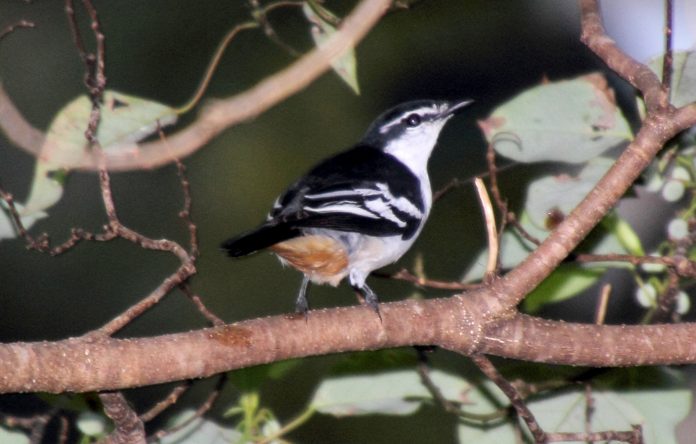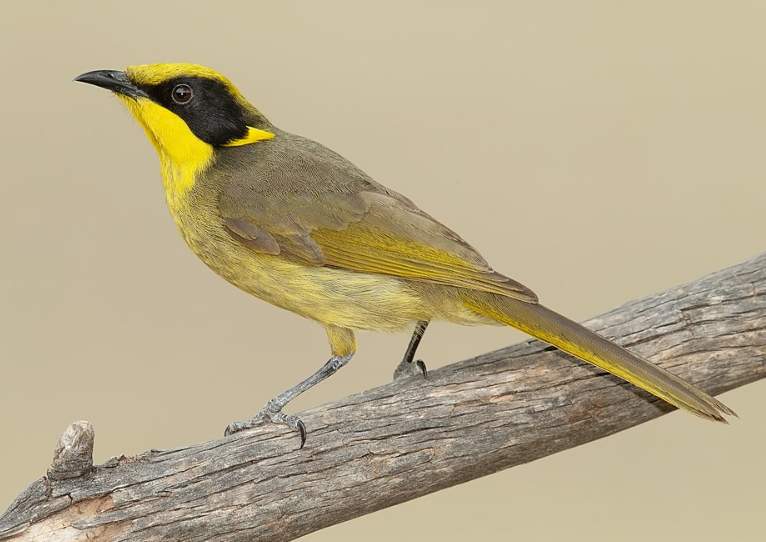Description: The Varied Triller (Lalage leucomela) is as unobtrusive as White-winged Trillers are conspicuous. They live within the canopy of dense forest, are fairly sedentary, stay in pairs or at most a family party of three year-round, and males give no showy song flight when breeding. Individual pairs seem to hold or keep to the same loose territory all year yet may never defend it very actively Even when breeding-being is dusky-tippedpermanently established it may be well-enough known.
Identification: The male upper parts are glossy black; rump grading is from dusky-tipped white (races yorki, rufiventris, macrura) to plain gray (race leucomela). Wings are black with broad white edging on wing coverts and inner secondaries. The tail is black and tipped white on outer feathers. Eyebrow white. Underparts are plain white except for pale cinnamon-rufous crissum (race yorki); or grey-white and faintly barred with deep cinnamon-rufous crissum (race leucomela); or rather uniformly pale buff with clear dusky barring (races rufiventris, macrura). Eye brown. Bill and feet black.
Female: As the male with slightly stronger ventral barring (race leucomela); as male but with strong ventral barring (race yorki); or as male but brownish backed (races rufiventris, macrura).
Immature: – As the female of the relevant race but greyer often flecked white on upper parts; rump rusty, barred black; underparts buffier and streaked as well as barred.
Song / Sounds / Call / Voice: – Varied Triller has churring trill, drr-eea drr-eea, repeated in short bursts between both sexes, in contact; a reflective kar-r-r-r. Also gives high notes at intervals and a trilling song.
Nesting: – The bird’s breeding season is from August till April, but mainly September-December. A small size nest, shallow saucer, 70 x 30 mm, of fine twigs and vine tendrils bound with spiderweb and ornamented with pieces of bark; lined with fine rootlets and lichen with egg chamber JO mm deep; usually placed in the horizontal fork. Egg: one; slightly glossy pale green, speckled, streaked, or blotched with red-chestnut to purple-brown and gray, sometimes concentrated at the larger end to form about 26 x 17 mm.
Distribution: – The bird prefers a warm, and moist environment, found in tropical and sub-tropical coastal of eastern Australia, Papua New Guinea. Pockets of rainforest and denser fringing scrubs around coastal northern and eastern Australia, in Kimberleys (race macrura), Arnhem Land (race rufiventris), Cape York Peninsula south to about Cairns to Townsville, QLD (race yorki), and thence south on the east coast to about Manning River, NSW (race leucomela). Sedentary; dispersed in moderate numbers. About 1 5 races; four in Australia.
Habitat: – Living in the tall thickets that fringe rainforests and range out along creeks into adjacent eucalypt and paperbark forests and even mangroves. Their feeding zone extends from the crown of trees down to the lower shrub layer. In rainforests, Varied Trillers usually stay in the upper and middle layers of the canopy, but in more open country, such as riverine thickets and open forest, they may forage low down, sometimes even on the ground.
Their progress is marked at all times by their churring contact calls, which both sexes utter repeatedly while foraging. At such times, they sometimes associate with other rainforest birds in mixed feeding flocks.
Nest: – Both sexes apparently build the nest, incubate and rear the single young. Their meager nest is proportionately the smallest of any Australian Cuckoo-shrike, and their single egg the largest. Though, the young are moderately advanced upon hatching. The four races of Varied Trillers in Australia are easily identified from White-winged Trillers by their bar-breasted females, rufous-vented males, and white brows in both sexes.
The two northwestern races are more female-plumaged than those in the east, such that their adult males match eastern females and their females are still duller brown-backed and more clearly barred on a uniformly pale ochre-buff under surface.
Read More: White-winged Triller

Diet: – Varied Trillers are as much fruit lovers, (favorite ones are Fig and flowering eucalyptus trees) sometimes seeds, nectar, and insect-eaters. When feeding, they move slowly through the foliage, searching carefully for insects and their larvae on and under leaves, twigs, and branches. They eat small fruits, which they swallow whole. Occasionally, the hawk catch flying insects. Any fruit that they take is small and eaten whole; figs are favored.
OTHER NAMES – White-browed Triller, White-browed Caterpillar-eater. (Spanish – Oruguero Variable), (Italian: Trillatore cigliabianche), (Dutch: Witbrauwtriller), (German: Weißbrauenlalage).
LENGTH: Varied Triller length is about 180-200 mm.
Status: The population is decreasing due to the cutting of rainforests.
Read More – White-tufted Sunbeam (Aglaeactis castelnaudii)







